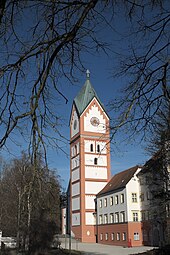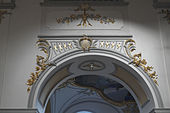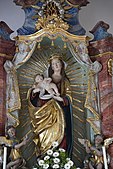Holy Cross and Assumption of Mary (Scheyern)
The Catholic parish and Benedictine abbey church of the Holy Cross and Assumption of Mary in Scheyern , a municipality in the Pfaffenhofen an der Ilm district in Bavaria , is essentially a late Romanesque building from the 12th / 13th centuries. Century. The church was built as the monastery church of the Benedictine Abbey of Scheyern , the house monastery of the Wittelsbach family , which served as their burial place until 1253. In the 16th and 18th centuries the church was extensively redesigned, and in the 19th century it was re-Romanized. In 1980 it was elevated to a minor basilica . The church is one of the protected architectural monuments in Bavaria.
Since the end of the 12th century, the church has owned a cross relic , the Scheyr Cross . Today it is kept in the Holy Cross Chapel and is the destination of a pilgrimage .
history
In 1119, Count Otto V. von Scheyern settled the Wittelsbach monastery , which was founded in Bayrischzell in 1077 and later moved to Fischbachau and Petersberg in the Dachau district , on the site of his former ancestral castle in Scheyern, which he had left in favor of Wittelsbach Castle . A church was consecrated around 1127/28, which was destroyed in fires in 1171 and 1183. In the period that followed, a new church was built, which was consecrated in 1215 and the core of which has been preserved to this day. This late Romanesque building with a change of pillars was twelve meters shorter than today's church, had a west porch and three apses .
Around 1440/50, a two-story sacristy was built on the site of the southern apse, today's royal chapel . At the same time, the Romanesque tower was raised and in 1837 Friedrich von Gärtner gave it a new Romanesque helmet.
From 1768 to 1770 the church was redesigned in the late rococo style . The central nave was lengthened, the originally Romanesque windows were enlarged in the shape of a pear, the chapels of the north aisle were joined together to form a further aisle and the church was given new fittings.
After the abolition of the monastery in 1803 in the course of secularization , the monastery church became the new parish church of Scheyern. The previous parish church of St. Martin was demolished at that time.
In the years 1876 to 1878 the church was re- romanised , it was given a neo-Romanesque facade, the stucco was partially removed and the rococo frescos created by Johann Georg Dieffenbrunner were replaced by themed pictures in the style of the Nazarenes .
architecture
The interior has three aisles and is vaulted by a needle cap barrel. There is no transept . The choir, closed on three sides , is taken up in its entire width by the high altar .
Frescoes
The ceiling frescoes in the central nave were made by Otto Hämmerle in 1923/24 . They depict the Assumption and the Coronation of Mary above the chancel, the glorification of St. Benedict in the middle and the finding and exaltation of the Holy Cross above the organ gallery .
Fragments of frescoes from 1770 by Johann Georg Dieffenbrunner have been preserved under the organ gallery .
Piece
The stucco decor was created in 1768 by Ignaz Finsterwalder from Wessobrunn .
Holy Cross Chapel
The original frescoes, which Melchior Buchner (also Puchner or Büchner) , who came from Schongau and later worked in Ingolstadt, have been preserved in the Heiligkreuzkapelle . Have them remember the blessings that come from the cross of Christ. In 1768/69 the chapel was redesigned in the early Rococo style by Wessobrunn plasterers such as Ignaz Finsterwalder . The mirrors built into the stucco are supposed to symbolize the divine shine.
The cross altar from 1738 has a large Renaissance cross from around 1600, the figures of St. Helena and St. Mary Magdalene are dated around 1650. The Scheyr Cross is kept in the tabernacle in a monstrance created by Johann Georg Herkommer in 1738 .
Further equipment
- The high altar was created around 1770. The Assumption of Mary is depicted on the altar sheet by Christian Wink from 1771 .
- The figures of St. Boniface and St. Erasmus at the choir entrance come from the Frauenkirche in Munich and were made around 1765 in Ignaz Günther's workshop .
- The Madonna figure on the Marian altar is dated to 1467. It probably stood on the former high altar.
organ
Bells
The five-part cast steel bell from 1947, tuned to g ° -b ° -des'-fes'-g ', had to be partially shut down after 2008. As a result, a new bronze bell was purchased. A bell from 1921 and a bell from 1816 were integrated into the new bell. The other bells were made in the Perner bell foundry in Passau. The big bell is the largest bell in Bavaria.
| No. | Surname | Casting year | volume | Weight (kg) |
|---|---|---|---|---|
| 1 | Christ Salvator | 2009 | e ° + 5 | 10.100 |
| 2 | Maria | 2009 | g sharp ° + 4 | 4,840 |
| 3 | Benedictus | 2009 | h ° + 6 | 3,340 |
| 4th | Holy cross | 2009 | c sharp '+ 4 | 2,253 |
| 5 | Martin and Korbinian | 1816 | f sharp '+ 3 | 710 |
| 6th | Mary Magdalene | 2009 | g sharp '+ 4 | 695 |
| 7th | Joseph | 1921 | ais' + 6 | 370 |
| 8th | John the Baptist | 2009 | h '+ 6 | 525 |
| 9 | Guardian Angel | 2009 | cis '' + 4 | 427 |
| 10 | Matthew | 2009 | e '' + 6 | 237 |
| 11 | Markus | 2009 | f sharp '' + 4 | 161 |
| 12 | Heart of jesus | 2009 | g sharp '' + 3 | 95 |
| 13 | Luke | 2009 | a '' + 4 | 88 |
| 14th | John | 2009 | h '' + 5 | 79 |
literature
- * Georg Dehio : Handbook of German Art Monuments. Bayern IV: Munich and Upper Bavaria . 2nd edition, Deutscher Kunstverlag, Munich 2002, ISBN 3-422-03010-7 , pp. 1073-1075
- Jolanda Drexler-Herold, Angelika Wegener-Hüssen: Landkreis Pfaffenhofen ad Ilm (= Bavarian State Office for Monument Preservation [Hrsg.]: Monuments in Bavaria . Volume I.19 ). Karl M. Lipp Verlag, Munich 1992, ISBN 3-87490-570-5 , p. 258-268 .
Web links
- The Papal Basilica of Scheyern Scheyern Monastery (accessed January 1, 2016)
Individual evidence
- ↑ List of monuments for Scheyern (PDF) at the Bavarian State Office for Monument Preservation, monument number D-1-86-151-11
- ↑ The Scheyr Cross and its History Scheyern Monastery (accessed on January 1, 2016)
- ↑ The bells of the Scheyern Basilica Scheyern Monastery (accessed on March 11, 2018)}
Coordinates: 48 ° 30 ′ 10.6 ″ N , 11 ° 27 ′ 18 ″ E












